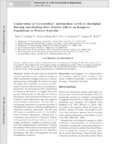1 - 25 of 6
| Creator | Title | Description | Subject | Date | ||
|---|---|---|---|---|---|---|
| 1 |
 |
Wiessner, Pauline W. | Wealth transmission and inequality among hunter-gatherers | We report quantitative estimates of intergenerational transmission and population-wide inequality for wealth measures in a set of hunter-gatherer populations. Wealth is defined broadly as factors that contribute to individual or household well-being, ranging from embodied forms, such as weight and h... | 2010-02 | |
| 2 |
 |
Codding, Brian | Conservation or co-evolution? Intermediate levels of aboriginal burning and hunting have positive effects on kangaroo populations in Western Australia | Studies of conservation in small scale societies typically portray indigenous peoples as either sustainably managing resources, or forsaking long-term sustainability for short-term gains. To explain this variability, we propose an alternative framework derived from a co-evolutionary perspective. In ... | 2014-01-01 | |
| 3 |
 |
Codding, Brian | Alternative aboriginal economies: Martu livelihoods in the 21st century | In the western deserts of Australia, hunting and gathering endures as an important social and economic activity. That foraging persists within the boundaries of developed industrialized nation states may come as a surprise to those who evaluate foraging as less profitable than agricultural, wage or ... | Aboriginal economics; Aboriginal foraging | 2015 |
| 4 |
 |
Codding, Brian F. | Explaining prehistoric variation in the abundance of large prey: a zooarchaeological analysis of deer and rabbit hunting along the Pecho Coast of Central California | Three main hypotheses are commonly employed to explain diachronic variation in the relative abun dance of remains of large terrestrial herbivores: (1) large prey populations decline as a function of anthro pogenic overexploitation; (2 ) large prey tends to increase as a result of increasing social p... | Foraging; Resource depression; Prestige hunting; Paleoclimatic variability; Human behavioral ecology; Zooarchaeology; Central California | 2009-11-14 |
| 5 |
 |
Codding, Brian F. | Interpreting abundance indices: some zooarchaeological implications of Martu foraging | Indices of taxonomic abundance are commonly used by zooarchaeologists to examine resource inten sification, overexploitation and gender divisions in foraging labor. The original formulation of abundance indices developed a clear interpretive framework by linking the measure with foraging models from... | Human behavioral ecology; Zooarchaeology; Ethnoarchaeology; Resource intensification; Gender division of labor; Western Australia | 2010-07-20 |
| 6 |
 |
Broughton, John | Prehistoric human impacts on California birds: evidence from the Emeryville Shellmound Avifauna | The abundance of artiodactyls, marine mammals, waterfowl, seabirds, and other animals in 18th- and 19th-century California astonished early explorers, and the incredible wildlife densities reported in their accounts are routinely taken as analogues for the original or pristine zoological condition. ... | Avifauna; Prehistoric hunting; Biological evaluation of environmental impacts | 2004 |
1 - 25 of 6
